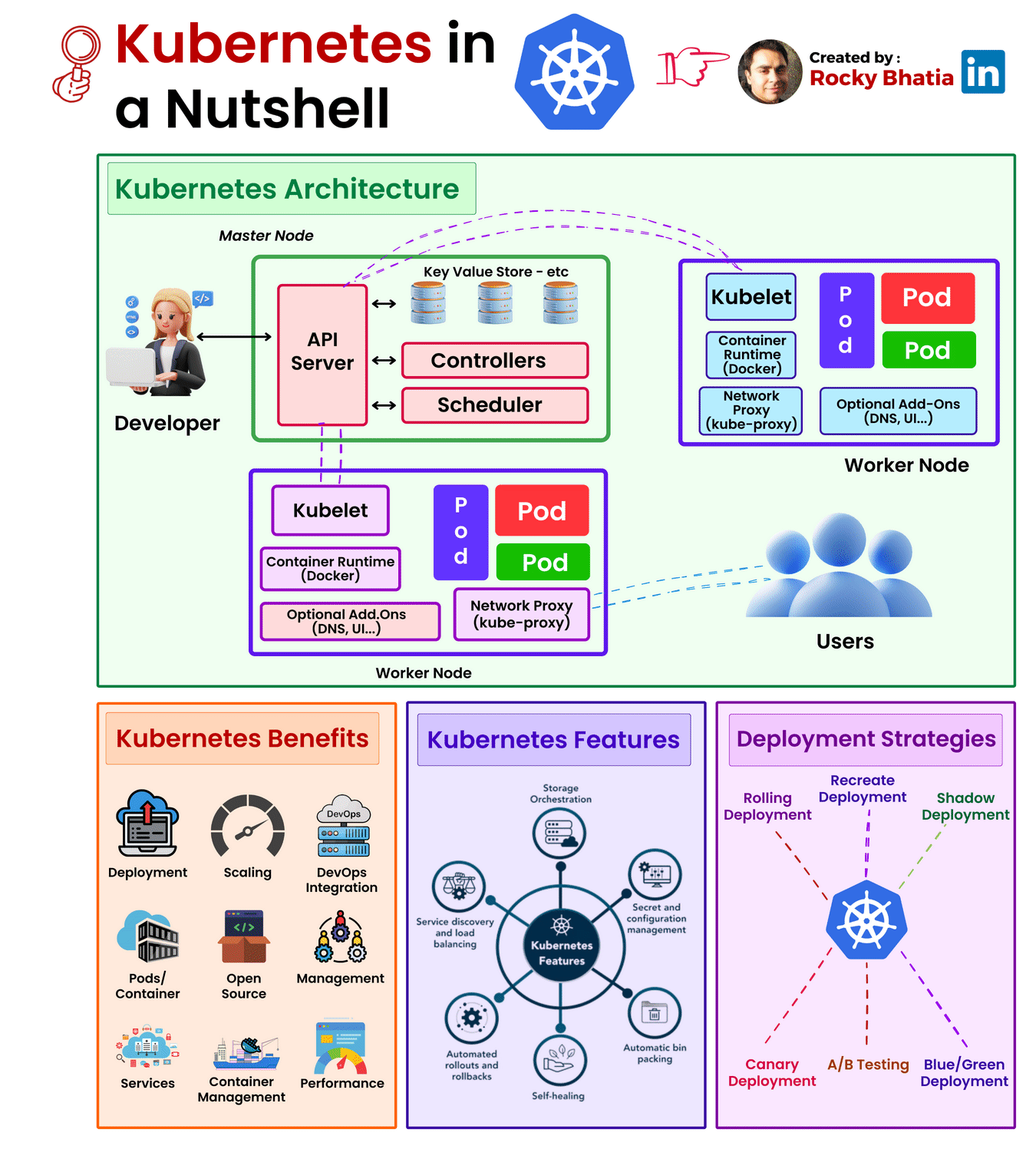
1+
4
Kubernetes, also known as K8s, is an open-source container orchestration platform. It automates many of the manual processes involved in deploying, managing, and scaling containerized applications. Kubernetes groups containers that make up an application into logical units for easy management and discovery. K8s builds upon 15 years of experience of running production workloads at Google, combined with best-of-breed ideas and practices from the community.
Kubernetes provides a number of features that make it a popular choice for running containerized applications, including:
- Container orchestration: Kubernetes automates many of the manual processes involved in deploying, managing, and scaling containerized applications. This makes it easier to run containerized applications in production environments.
- Service discovery and load balancing: Kubernetes provides a built-in service discovery and load balancing mechanism. This makes it easy to deploy and manage microservices-based applications.
- Self-healing: Kubernetes automatically restarts failed containers and reschedules them to healthy nodes. This helps to ensure that your applications are always available.
- Horizontal scaling: Kubernetes makes it easy to horizontally scale your applications by adding or removing nodes. This allows you to scale your applications up or down as needed.
Kubernetes is a complex platform, but it is also very powerful. It can be used to run a wide variety of applications, from simple websites to complex microservices-based applications.
Here are some of the benefits of using Kubernetes:
- Increased efficiency: Kubernetes can automate many of the manual tasks involved in managing containerized applications. This can free up your team to focus on more important tasks.
- Improved scalability: Kubernetes makes it easy to scale your applications up or down as needed. This can help you to save money on infrastructure costs.
- Increased reliability: Kubernetes includes a number of features that help to improve the reliability of your applications, such as self-healing and automatic restarts.
- Reduced complexity: Kubernetes can help to reduce the complexity of managing containerized applications. This is because Kubernetes provides a single platform for managing all aspects of your containerized applications.
If you are considering using Kubernetes to run your containerized applications, there are a few things you should keep in mind:
- Kubernetes is a complex platform: Kubernetes is not a simple platform. It takes time and effort to learn how to use it effectively.
- Kubernetes requires a certain level of expertise: Kubernetes is not for everyone. It requires a certain level of expertise to set up, manage, and troubleshoot Kubernetes clusters.
- Kubernetes is not a silver bullet: Kubernetes is not a silver bullet for all of your containerized application needs. It is important to understand the limitations of Kubernetes before you start using it.
Here are some key concepts and components of Kubernetes:
- Containers: Kubernetes is designed to work with containerized applications, typically using Docker containers. Containers package applications and their dependencies, making them portable and consistent across different environments.
- Nodes: A Kubernetes cluster consists of a collection of physical or virtual machines called nodes. Each node runs container runtime software (e.g., Docker) and communicates with the control plane.
- Control Plane: The control plane is the brain of the Kubernetes cluster. It manages the overall state of the cluster and makes decisions about where to deploy and scale applications. Key components of the control plane include the Kubernetes API server, etcd (a distributed key-value store), the scheduler, and the controller manager.
- Pods: The smallest deployable unit in Kubernetes is a pod. A pod can contain one or more containers that share the same network namespace and storage volume. Containers within a pod are tightly coupled and typically work together.
- Replica Sets and Deployments: Replica Sets and Deployments are used to define and manage the desired number of pod replicas. Deployments allow you to declaratively manage updates and rollbacks of applications.
- Services: Kubernetes Services provide a stable network endpoint (IP address and DNS name) for accessing a group of pods. Services enable load balancing and service discovery within the cluster.
- Namespaces: Namespaces provide a way to logically partition a Kubernetes cluster into multiple virtual clusters. They are used to isolate resources and manage access control.
- ConfigMaps and Secrets: ConfigMaps allow you to decouple configuration data from your application code, while Secrets are used to store sensitive information, such as API keys and passwords.
- Volume Storage: Kubernetes provides various types of volume storage options, including Persistent Volumes (PVs) and Persistent Volume Claims (PVCs), for managing data storage in containers.
- Ingress Controllers: Ingress Controllers manage external access to services within the cluster, typically by configuring HTTP and HTTPS routing rules.
- Auto Scaling: Kubernetes supports both horizontal and vertical auto scaling. Horizontal Pod Auto Scaling (HPA) automatically adjusts the number of pod replicas based on resource utilization, while Vertical Pod Auto Scaling (VPA) adjusts the CPU and memory requests and limits of pods.
- Health Checks: Kubernetes supports readiness and liveness probes that help ensure the availability and reliability of applications. Readiness probes determine when a pod is ready to serve traffic, while liveness probes determine if a pod should be restarted.
- Logging and Monitoring: Kubernetes integrates with various logging and monitoring solutions, including Prometheus and Grafana, to collect metrics and monitor the health of applications.
- Container Network Interface (CNI): CNI plugins provide networking capabilities to pods, allowing them to communicate with each other and external services.
- Security: Kubernetes offers security features such as Role-Based Access Control (RBAC), PodSecurityPolicies, and Network Policies to control access and secure the cluster.
- What is Mobile Virtual Network Operator? - April 18, 2024
- What is Solr? - April 17, 2024
- Difference between UBUNTU and UBUNTU PRO - April 17, 2024

